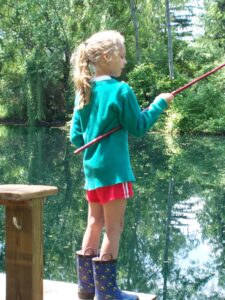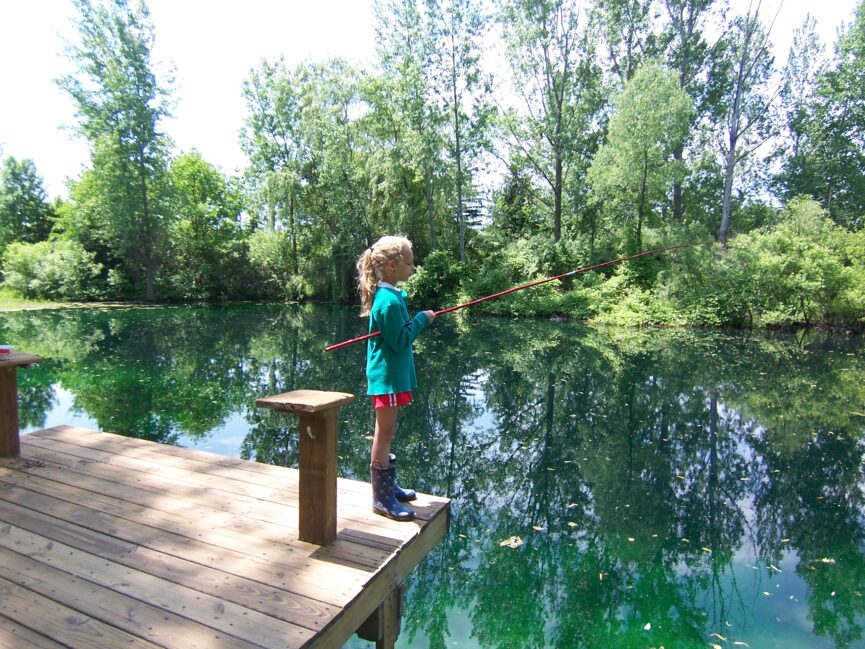Most folks often assume the Dog Days get their name from the mid to late summer’s dry and hot weather which of course, can be hard on dogs. However, the name comes from the late summer timeframe in which the Dog Star, “Sirius”, named by ancient Romans, can be readily seen. The Dog Days timeframe is typically July 3 to August 11, but for me, it runs from the beginning of July all the way to mid-September, and it is when I truly enjoy fishing during a very relaxing and often sultry atmosphere. I’m primarily a river fisherman and enjoy employing various techniques and tackle by wading, using a canoe or casting from the riverbank. I often use a flyrod or an ultralight spin casting rig, but my favorite is a cane pole featuring utter simplicity using just a “stick and string” concept, which I have found can be quite effective.
Fishing of course has a whole bunch of history and primitive humans first started to fish with spears and crude nets. Somewhere along the way, a convenient way to catch fish, especially in deeper waters, was to use a baited hook and line. This was in the form of hand lining which is hanging onto the line with bare hands. When an inquisitive soul figured out a tree branch allowed for more diversity and reach when casting for more effective fishing opportunities, the first fishing pole was born and the evolution of the fishing tackle we know today began. The fly rod of today got its start in merry old England as a slender rod whittled from a wood called “green heart” and using horsehair fishing line and no reel – reels would come much later.
There is something to be said about using a simple stick and string for fishing, because there is no fuss or muss entailed to the whole affair. Being from the baby boomer generation, my first fishing experiences were with long bamboo fishing poles, which everyone referred to as “cane poles”. These weren’t the jointed poles which come apart in sections, but rather a single long piece of bamboo that had to be strapped on top or alongside of the car to reach the fishing spot.
Yep folks, those long, bamboo cane poles were quite effective fishing tools allowing for accurate placement of the baited hook. The lengthy and slender bamboo allowed for acute sensitivity in feeling a fish nibbling on the bait and can take quite a beating while landing a feisty fish, and it is as simple as lifting the pole’s tip straight upward in a steady manner, a very simple matter of geometry.
When my three sons came along, and with a farm pond in our backyard, summertime fishing became a way of life here. Not wanting to deal with the typical snarls and “birds’ nests” in lines often encountered with kids and reels, I opted right away to start them out with cane poles. My favorite cane pole is 12 feet long, comes in three sections that are 4 feet long and, unlike the cane poles of my youth, it is an easy matter to transport to and from fishing spots. It is also, despite its length, well balanced from its hefty butt to its slender, but strong tip. Its sheer simplicity causes an already relaxing pastime to become even more laidback. On top of that, it is also very effective in catching fish in a brush-lined river environment. Presenting bait or even artificial lures and spoons can be performed with a unique dexterity, including targeting small, open pockets of water in a myriad of lily pads or reeds.

A handy dock and an efficient and easy-to-use cane pole is the perfect combination for a kid fishing during the Dog Days of summer.
My method of rigging a cane pole is basically very straightforward, and like the tackle in general, quite simple. I use 10 lb Dacron line attached to the pole’s tip and then tie it again about 3 inches further back for more durability when dealing with feisty fish and cut the line off at the same length as the cane pole. I then on put a swivel-snap for attaching hooks on monofilament leaders, or a wire leader if I know a pike might be lurking about in the lily pads. My result is casting a line out that is just slightly longer than the already lengthy cane pole, which I have found to be more than adequate and very manageable for near shore, off a dock, and especially for river fishing. I’m certainly not looking to fish into deep and murky depths, but instead, I pick my ground, so to speak, for employing this timeless system.
Although I often use live bait with a cane pole, I don’t hesitate to try out artificial bait including spoons, flies and bass poppers. It is easy to create the necessary action required by simply lifting and wiggling the cane pole’s tip in a methodical upward fashion. When it comes to the various lures that I will use during the Dog Days, my favorite color is green to duplicate frogs, which are especially appealing to hungry fish which haven’t been on a recent feeding frenzy due to an ongoing lack of insect hatches. Another delectable during this timeframe, besides minnows, is crayfish, and I have come to appreciate “soft plastics” which realistically duplicate minnows, frogs and crayfish while also incorporating authentic colors, which are very important because fish aren’t colorblind. A new artificial favorite of mine I’m frequently using is the (made in Michigan’s Thumb) “Thump ‘Em Soft Plastics” which come in a wide variety of colors, sizes and types, including some which even glow in the dark. You might say I’m giving these (locally made) authentic-looking lures a “Thumbs up”!
Michigan offers great fishing opportunities in a whole lot of rivers statewide, and now that the Dog Days are finally here, I plan on sampling a few of my favorites, which includes my close-to-home Cass River.
And yep, folks, a lot of it will be done with a simple to use, but effective, stick and string concept commonly referred to as a cane pole.
- Fickle weather during December deer hunting adventures - December 3, 2025
- Michigan’s most popular opening day – November 15th - November 23, 2025
- A missing dog found while anticipating opening day - November 23, 2025

